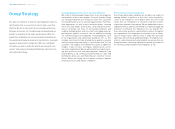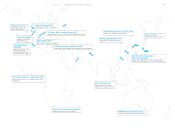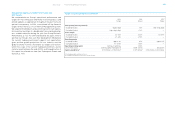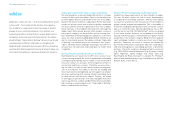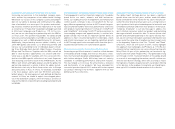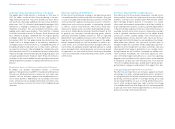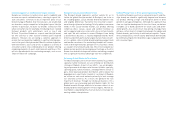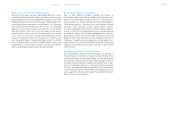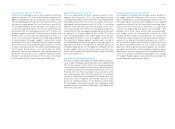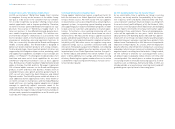Reebok 2006 Annual Report Download - page 58
Download and view the complete annual report
Please find page 58 of the 2006 Reebok annual report below. You can navigate through the pages in the report by either clicking on the pages listed below, or by using the keyword search tool below to find specific information within the annual report.› Structure and StrategyGroup Management Report ›
054 ANNUAL REPORT 2006 › adidas Group ›
adidas Sport Style: Expanding the Power of the Brand
The adidas Sport Style division is entering its fifth year in
2007. At adidas, we know that niche marketing is increas-
ingly important and that successful brands are those which
can reach not only larger audiences but also small and influ-
ential ones. Our Y-3 collection, developed with designer Yohji
Yamamoto, is helping us extend our product appeal to cos-
mopolitan consumers who are looking for exclusive, style-
leading active sportswear products. The collection is limited
to fashion-oriented accounts in Europe, North America and
Asia. Influential designs combined with the highest quality
standards clearly distinguish Y-3 from any other product in
the market. With Y-3, the adidas brand has distinctly estab-
lished itself as a design leader in the industry. Yamamoto’s
strong presence in this area allows us to expand the power of
the adidas brand to help reach out to style setters and fash-
ion industry visionaries. We extended the collaboration with
Yohji Yamamoto until 2010 to influence the sports and fashion
industry through innovative design and intriguing ideas and
concepts going forward. However, Sport Style will remain a
small part of the overall adidas business going forward as we
intend to generate around 1% of adidas brand revenues in this
division.
Distribution: Focus on Wholesale and Own-Retail Business
At adidas, our product distribution follows a two-fold
approach. We generate around 85% of adidas brand revenues
through our wholesale business, where our own sales sub-
sidiaries sell our footwear, apparel and hardware/accesso-
ries to retail partners. Additionally, we run adidas own-retail
stores, where we sell our products directly to consumers. Our
own-retail business accounts for close to 15% of adidas brand
revenues.
Wholesale: Building a Broad Platform
At the core of our wholesale strategy is the idea that we want
a mutually beneficial relationship with our retailers. Our goal
is to be a valuable and reliable business partner to them. We
work closely with regional and local key accounts, often pro-
viding them with exclusive product or marketing concepts
as well as shop-in-shop initiatives. We strive to avoid over-
exposure to any particular customer, by broadening our pres-
ence across all distribution channels (see Risk Report, p. 96).
In general, our customers include sporting goods, athletic
specialty and family footwear retailers as well as high-end
department stores and directional accounts in the Sport Heri-
tage division. To preserve the premium image of the adidas
brand, we generally do not sell our products to value or dis-
count chains. Our customer base varies by region and coun-
try. In China, for example, retailers typically operate so-called
mono-branded stores, which generally carry only one brand.
As opposed to our own retail activities, these mono-branded
stores are owned and run by external partners (2006: around
3,000 stores).
Own Retail: Important Pillar of adidas Business
Own retail consists of four major components: concept stores,
factory outlets, internet sales and concession corners in Asian
markets. Concept stores market Sport Performance and/or
Sport Heritage products directly to consumers in a stand-
alone retail environment and provide us with high visibility in
major metropolitan locations as well as growth opportunities
in Eastern Europe and Asia where less retail infrastructure is
available. Factory outlet stores are also stand-alone concepts
used to optimize clearance activities for the adidas brand.
Concession corners provide adidas sales infrastructure to
emerging markets in Asia. Internet sales, which are increas-
ingly important in North America, are available at the Group’s
www.adidas.com website. Our own-retail activities give us
valuable insight into consumer trends and product position-
ing. We share this insight with our retail customers, who also
often benefit from being in proximity to our concept stores.
Going forward, we will continue to expand our adidas own-
retail activities worldwide. Our own-retail expansion, how-
ever, will remain opportunity-driven, i.e. new store openings
depend on the availability of the right location. In the medium
to long term, we plan our own-retail business to account for
15 to 20% of adidas brand sales and we want to grow overpro-
portionately in categories and markets that support this aim.
Pricing Strategy: Driving Premium Price Points
We offer the vast majority of our footwear, apparel and hard-
ware products at high- and mid-level price points. Our goal is
to strengthen both our brand’s market position and revenues
by driving continuous growth in average selling prices and
increasing profitability. In case of strong promotional activi-
ties at retail, we proactively take steps to protect the image
of the adidas brand (see Risk Report, p. 96), and are prepared
to give up short-term revenue opportunities as necessary to
preserve our long-term market position.


